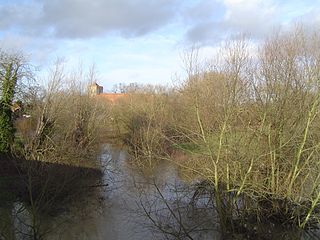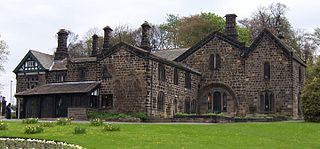
Oxfordshire is a historic, ceremonial and non-metropolitan county in South East England. It is a mainly rural county, with its largest settlement being the city of Oxford. The county is a centre of research and development, primarily due to the work of the University of Oxford. Oxfordshire is locally governed by Oxfordshire County Council, together with the lower tier councils of its five non-metropolitan districts: City of Oxford, Cherwell, South Oxfordshire, Vale of White Horse, and West Oxfordshire. The ceremonial county is landlocked and bordered by Northamptonshire to the north-east, Warwickshire to the north-west, Buckinghamshire to the east, Berkshire to the south, Wiltshire to the south-west, and Gloucestershire to the west. The areas of Oxfordshire south of the River Thames were part of the historic county of Berkshire, including the county's highest point, the 261-metre (856 ft) White Horse Hill.

Lacock Abbey in the village of Lacock, Wiltshire, England, was founded in the early 13th century by Ela, Countess of Salisbury, as a nunnery of the Augustinian order. The abbey remained a nunnery until the suppression of Roman Catholic institutions in England in the 16th century; it was then sold to Sir William Sharington who converted the convent into a residence where he and his family lived. It was fortified and remained loyal to the crown during the English Civil War, but surrendered to the Parliamentary forces once Devizes had fallen in 1645.

Dorchester on Thames is a village and civil parish in Oxfordshire, about 3 miles (5 km) northwest of Wallingford and 8 miles (13 km) southeast of Oxford. The town is a few hundred yards from the confluence of the River Thames and River Thame. A common practice of the scholars at Oxford was to refer to the river Thames by two separate names, with Dorchester on Thames the point of change. Downstream of the village, the river continued to be named The Thames, while upstream it was named The Isis. Ordnance Survey maps continued the practice by labelling the river as "River Thames or Isis" above Dorchester, however, this distinction is rarely made outside the city of Oxford.

The River Thame is a river in Southern England. A tributary of the River Thames, the river runs generally south-westward for about 40 mi (64 km) from its source above the Buckinghamshire town of Aylesbury to the Thames in south-east Oxfordshire.

Lesnes Abbey is a former abbey, now ruined, in Abbey Wood, in the London Borough of Bexley, southeast London, England. It is a scheduled monument, and the abbey's ruins are listed at Grade II by Historic England. The adjacent Lesnes Abbey Woods are a Local Nature Reserve. Part of the wood is the Abbey Wood SSSI, a geological Site of Special Scientific Interest which is an important site for early Tertiary fossils.

The Abbey of St Mary is a ruined Benedictine abbey in York, England and a scheduled monument.

Reading Museum is a museum of the history of the town of Reading, in the English county of Berkshire, and the surrounding area. It is accommodated within Reading Town Hall, and contains galleries describing the history of Reading and its related industries, a gallery of artefacts discovered during the excavations of Calleva Atrebatum, a copy of the Bayeux Tapestry, finds relating to Reading Abbey and an art collection.

Mottisfont Abbey is a historical priory and country estate in Hampshire, England. Sheltered in the valley of the River Test, the property is now operated by the National Trust. 393,250 people visited the site in 2019. The site includes the historic house museum which features regularly changing art exhibitions, gardens, including a walled rose garden which is home to the National Collection of ancestral species and 19th-century rose cultivars, and a riverside walk. It is a Grade I listed building.

The Diocese of Leicester is a Church of England diocese based in Leicester and including the current county of Leicestershire. The cathedral is Leicester Cathedral, where the Bishop of Leicester has his episcopal chair.
Sopwell Priory was a Benedictine nunnery founded around 1140 on the site of an ancient hermitage in Sopwell, Hertfordshire, England. After the Dissolution, the priory was torn down and a Tudor manor house constructed in its place.

The River & Rowing Museum in Henley-on-Thames, Oxfordshire, England, is located on a site at Mill Meadows by the River Thames. It has three main themes represented by major permanent galleries, the non-tidal River Thames, the international sport of rowing and the local town of Henley-on-Thames.

South Stoke is a village and civil parish on an east bank of the Thames, about 1.5 miles (2.4 km) north of Goring-on-Thames in South Oxfordshire. It includes less than 1 mile (1.6 km) to its north the hamlet and manor house of Littlestoke.

Berinsfield is an English village and civil parish in South Oxfordshire, about 7 miles (11 km) southeast of Oxford. The 2011 Census recorded the parish population as 2,806.

"The Isis" is an alternative name for the River Thames, used from its source in the Cotswolds until it is joined by the Thame at Dorchester in Oxfordshire. It derives from the ancient name for the Thames, Tamesis, which in the Middle Ages was believed to be a combination of "Thame" and "Isis". Notably, the Isis flows through the city of Oxford.

The Abbey Church of St Peter and St Paul, more usually called Dorchester Abbey, is a Church of England parish church in Dorchester on Thames, Oxfordshire, about 8 miles (13 km) southeast of Oxford. It was formerly a Norman abbey church and was built on the site of a Saxon cathedral.

Drayton St. Leonard is a village and civil parish on the River Thame in Oxfordshire, about 8 miles (13 km) southeast of Oxford.

Abbey House Museum in Kirkstall, Leeds, West Yorkshire, England is housed in the gatehouse of the ruined 12th-century Kirkstall Abbey, and is a Grade II* listed building. The house is 3 miles (4.8 km) north west of Leeds city centre on the A65 road. It is part of the Leeds Museums & Galleries group.

The Vale and Downland Museum is a local museum in the market town of Wantage, Oxfordshire, England. Its galleries present the cultural heritage of the Vale of White Horse region around Wantage. A Victorian kitchen, Iron Age skeleton and a bust of Sir John Betjeman are amongst its attractions, along with a cafe serving home-made food. During school holidays there are several themed days, most of which are 'entry by donation'.
Charlbury Museum is a local museum in the town of Charlbury, Oxfordshire, England. The museum and collections are organized and run by the Charlbury Society, which was founded in 1949.
The Aston Martin Heritage Trust (AMHT) is a Charitable Incorporated Organisation that manages the Aston Martin Museum an automobile museum presenting the history of Aston Martin cars. It is located off Dorchester Road in the village of Drayton St Leonard, South Oxfordshire, England.

















